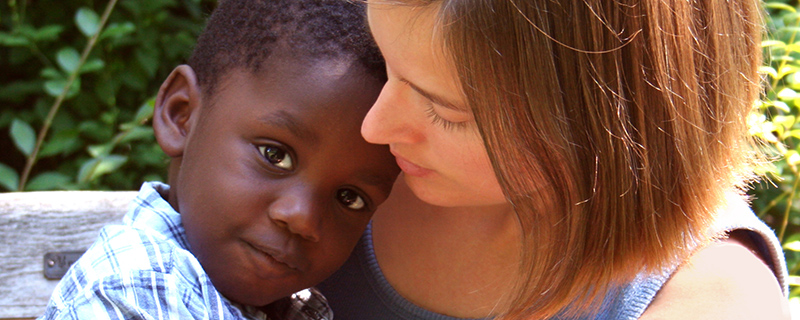
Blending In: Crisscrossing the Lines of Race, Religion, Family, and Adoption
Barbara Gowan, 2007
Where do I belong? Barbara Gowan sought to answer this question as she searched for the real meaning of family. The product of an interracial relationship in the 1960s, she lived in foster care before her adoption by loving—and complex—parents. In this candid account, she faces her long-standing inner conflicts with race, religion, and identity as she searches for her birth parents and her life’s purpose. Gowan’s emotional and inspirational story deals with overcoming abuse, loss, codependency, and rejection. She demonstrates how important the multifaceted concepts of faith, family, and love are in all human relationships, and how they form our sense of self. She shares not only her personal insights and revelations but also concrete strategies from other adoptees and respected professionals.
Cross-Cultural Adoption: How to Answer Questions from Family, Friends, and Community
Amy Coughlin and Caryn Abramowitz, 2004
Cross-Cultural Adoption is a refreshing book for all adoptive parents who are often confronted wherever they go with “the” questions. “Who are her real parents? Where is she from?” If adults aren’t careful, the answers can have devastating effects; if they are careful, the answers lay a solid foundation for fostering love, enriched families, and relationships.
Does Anyone Else Look Like Me? A Parent’s Guide to Raising Multiracial Children
Donna Jackson Nakazawa, 2003
A great book for helping ethnically-mixed kids to develop an understanding of their individuality and build self-esteem. “Am I black or white or am I American?” Does Anyone Else Look Like Me? includes professional commentary as well as scripts and stories that will become an invaluable reference for both adoptive and birth parents of mixed race children as they rear their children in an evolving world.
Inside Transracial Adoption
Gail Steinberg, 2012
This book provides creative, confident and pro-active guidance on how to build close, loving, and very real families consisting of individuals who are proud and culturally competent members of differing races. Drawing on research and personal experience, Steinberg and Hall offer detailed, step-by-step, get-real guidance for families about tough issues they have to face relating to race and adoption in domestic or international transracial adoptions: What’s “normal?” Where do we live and go to school? Does class have an influence? How do children develop racial identity? What kind of impact does being raised by white parents have on a black child? Combining humor with empathy and hard truths, this book is an established classic guide to living Inside Transracial Adoption.
In Their Own Voices: Transracial Adoptees Tell Their Stories
Rita J. Simon and Rhonda M. Roorda, 2000
How did being adopted transracially affect their lives through childhood and into adulthood? How did their family experiences influence their racial and social identities, their choice of friends and marital partners, and their lifestyles? In Their Own Voices collects the results of interviews conducted with black and biracial young adults who were adopted as children by white parents.
In Their Parents’ Voices: Reflections on Raising Transracial Adoptees
Rita Simon, Rhonda Roorda, 2007
These candid interviews shed light on the issues these parents encountered, what part race played during thirty plus years of parenting, what they learned about themselves, and whether they would recommend transracial adoption to others. Combining trenchant historical and political data with absorbing firsthand accounts, Simon and Roorda once more bring an academic and human dimension to the literature on transracial adoption.
Loving Across the Color Line: A White Adoptive Mother Learns About Race
Sharon Rush, 2000
What more could a liberal, white, civil rights law professor learn about the experiences of African Americans? Plenty. In this moving, heartfelt memoir of a mother and daughter’s loving relationship, the author describes how her eyes were opened to the harsh realities of the American racial divide. Only by living with her daughter through day-to-day encounters did she learn that racism is far more devastating to blacks than most whites can ever imagine.
Struggle for Identity: Issues in Transracial Adoption and A Conversation 10 Years Later (DVD)
NYS Citizens’ Coalition for Children, 2007
A thought-provoking video presenting a group of adoptees who discuss their experiences growing up in transracial adoptive families, followed by a follow-up 10 years later with two of the adoptees discussing their lifelong journeys as transracial adoptees. The two explore issues of racism, the visible and public nature of transracial adoption, loyalty and attachment, transracialization and creating multicultural families through the lens of their personal experience and professional training.
Transracial Adoption: Children and Parents Speak
Constance Pohl and Kathy Harris, 1992
The adoption of a child of one race by parents of another race is a complex, controversial issue. The authors explore the issue of transracial adoption through discussions with families.
Weaving a Family: Untangling Race and Adoption
Barbara Rothman, 2006
Weaving together the sociological, the historical, and the personal, Barbara Katz Rothman looks at the contemporary American family through the lens of race, race through the lens of adoption, and all-race, family, and adoption-within the context of the changing meanings of motherhood.
White Parents, Black Children: Experiencing Transracial Adoption
Darron Smith, Cardell Jacobson and Brenda Juarez, 2011
This book looks at the difficult issue of race in transracial adoptions–particularly the adoption by white parents of children from different racial and ethnic groups. Black children raised in white homes are not exempt from racism, and white parents are often naive about the experiences their children encounter. This book aims to bring to light racial issues that are often difficult for families to talk about, focusing on the racial socialization white parents provide for their transracially adopted children about what it means to be black in contemporary American society. Blending the stories of adoptees and their parents with extensive research, the authors discuss trends in transracial adoptions, challenge the concept of “colorblind” America, and offer suggestions to help adoptees develop a healthy sense of self.